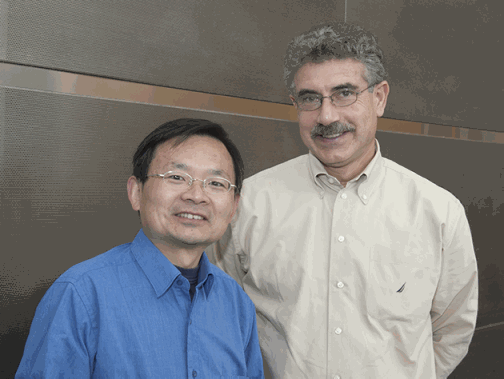George Srajer and Jin Wang, both of the Argonne X-ray Science Division (XSD) at the U.S. Department of Energy Office of Science’s Advanced Photon Source, have been elected Fellows of the American Physical Society (APS).
Srajer, who is an XSD Associate Division Director, was elected “For applications of synchrotron radiation to phase transitions and the structural and magnetic properties of single crystals, multilayers, and liquid crystals.” Srajer received his B.Sc. from the University of Belgrade, Serbia in 1980 and a Ph. D. in Physics from Brandeis University in 1988. After postdoctoral work at AT&T Bell Laboratories he started at the Advanced Photon Source as an Assistant Physicist in 1991. Since being at Argonne, Srajer has been the Group Leader for the Magnetic Materials, served as an advisor for four doctoral theses from Northwestern University in magnetism-related studies and was promoted to Senior Scientist in 2006. Srajer has published over 85 peer-reviewed papers and a book chapter. He is well-known both for his early work in liquid crystal structures and his more recent work using resonant and non-resonant x-ray techniques to study strongly correlated materials.
Wang, who is Group Leader of the Time Resolved Research Group in XSD, was elected “For contributions to the understanding of nanoparticle/polymer thin films and superlattices, and for the development of time-resolved X-ray methods for characterizing the structure of dense liquid sprays.” Wang obtained his B. S. from Nanjing University in 1984 and a Ph. D. from Ohio State University in 1994. After postdoctoral studies at Exxon, he started at Argonne as an Assistant Physicist in 1997. Wang’s development of grazing-incidence small-angle x-ray scattering at the APS has been used to study structure and dynamics in nanoscale thin films. His seminal development of synchrotron-based x-ray microimaging of high-pressure high-speed fuel sprays to understand structure and dynamics of complex sprays is widely considered a major breakthrough in combustion research. Wang has coauthored over 100 papers and received numerous awards for mentorship as well as the Sidhu Award of the Pittsburgh Diffraction Society.
Both were recommended for Fellowship by the APS Division of Condensed Matter Physics.
“The X-ray Science Division is proud and lucky to have both George Srajer and Jin Wang as staff members,” said Linda Young, Director of XSD. “It is through pioneering work such as theirs that x-ray science has been expanded to diverse applications from magnetism to soft matter, even liquid sprays. Their research encompasses fundamental studies of structural properties in condensed matter systems as well as research that has technological importance in the development of stronger magnetic materials, highly ordered nanostructures and optimized fuel injectors. We are delighted to see their work recognized by the Division of Condensed Matter Physics of the American Physical Society.”
According to information on the American Physical Society website, election to APS Fellowship is limited to no more than one half of one percent of the total APS membership. Each nomination is evaluated by the Fellowship committee of the appropriate APS division, topical group, or forum. After review by the APS Fellowship Committee, the successful candidates are elected by the APS Council. Fellowship is therefore a distinct honor signifying recognition by one's professional peers.
The Advanced Photon Source at Argonne National Laboratory is one of five national synchrotron radiation light sources supported by the U.S. Department of Energy’s Office of Science, Office of Basic Energy Sciences (DOE-BES). The APS is the source of the Western Hemisphere’s brightest high-energy x-ray beams for research in virtually every scientific discipline. More than 3,500 scientists representing universities, industry, and academic institutions from every U.S. state and several foreign nations visit the APS each year to carry out applied and basic research in support of the BES mission to understand, predict, and ultimately control matter and energy at the electronic, atomic, and molecular levels in order to provide the foundations for new energy technologies and to support DOE missions in energy, environment, and national security. To learn more about the Office of Basic Energy Sciences and its x-ray user facilities.
Argonne National Laboratory seeks solutions to pressing national problems in science and technology. The nation's first national laboratory, Argonne conducts leading-edge basic and applied scientific research in virtually every scientific discipline. Argonne researchers work closely with researchers from hundreds of companies, universities, and federal, state and municipal agencies to help them solve their specific problems, advance America's scientific leadership and prepare the nation for a better future. With employees from more than 60 nations, Argonne is managed by UChicago Argonne, LLC for the U.S. Department of Energy's Office of Science.

